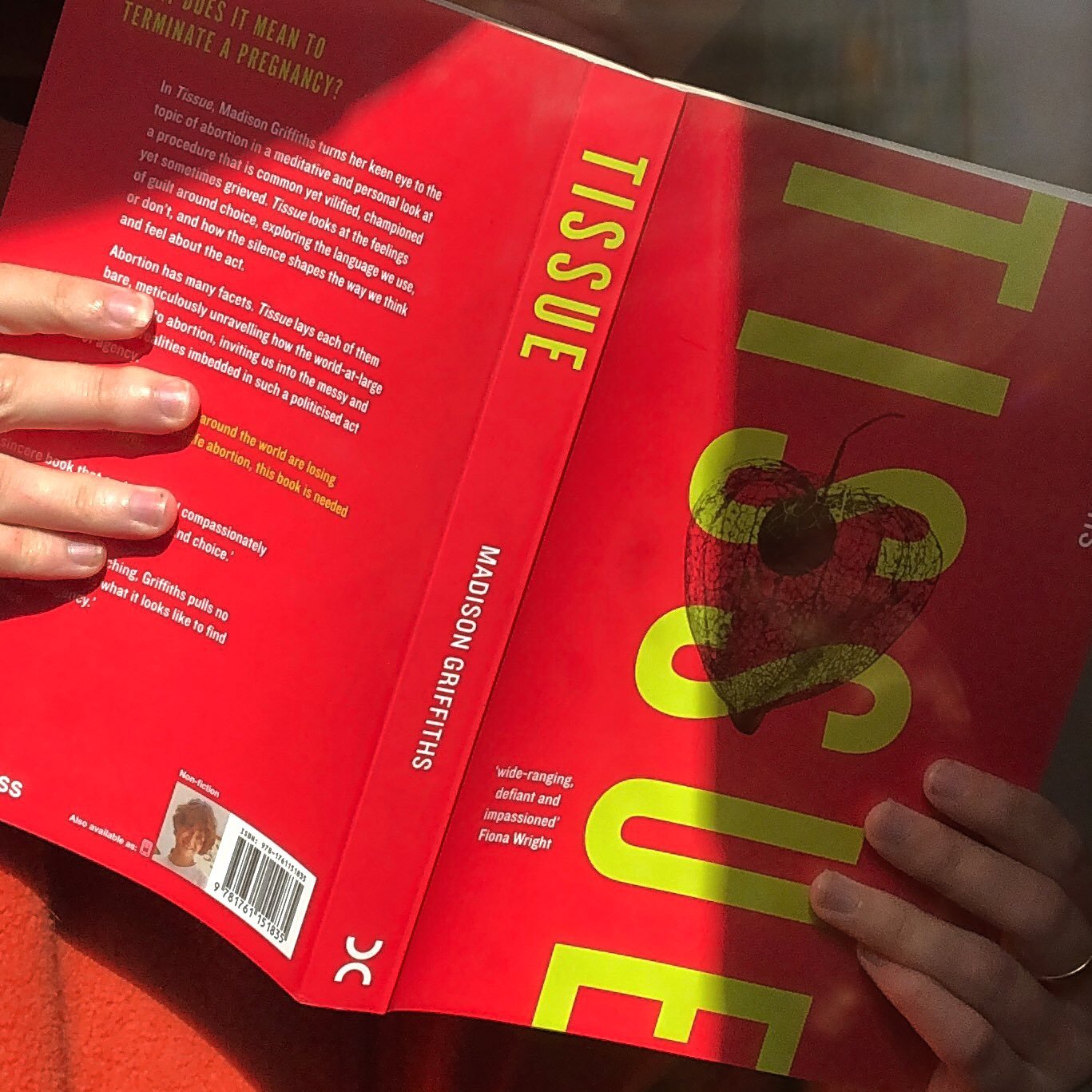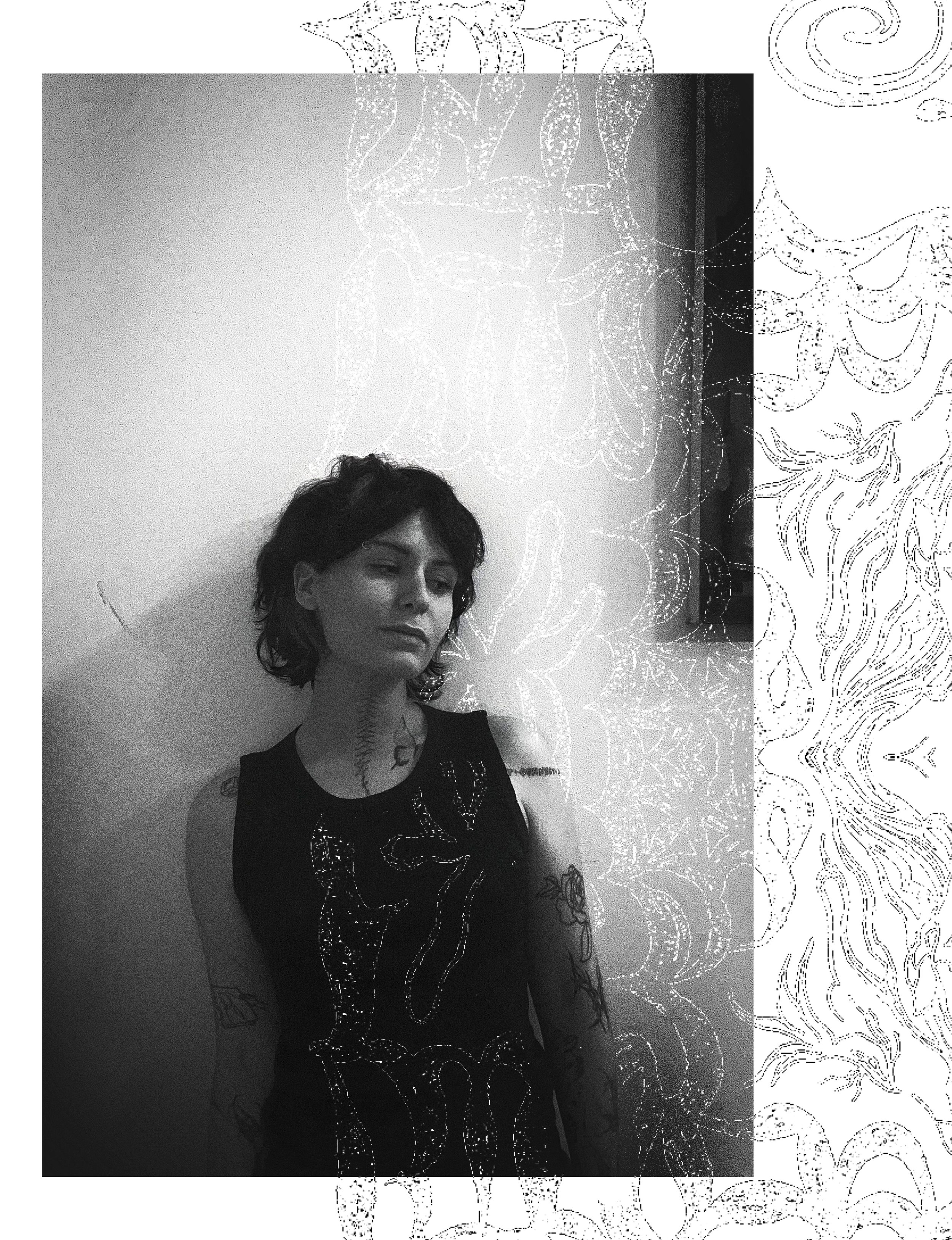
Madison Griffiths & Writing Vulnerability
Aideen Gallagher (she/her)
In this interview-based article with the Naarm-based tattoo artist, producer and writer Madison Griffiths (she/they), frequent Demure writer Aideen Gallagher (she/her) writes about Griffith's creative process and the extraordinary commitment taken to finish their first novel, Tissue. The novel is a meditative, personal look at abortion - a common procedure they describe as ‘championed yet grieved’, they reflect on the associated emotions and experiences faced in its aftermath while unravelling social responses to this politicised act of agency. Interested in the idea that creativity is an inherently vulnerable pursuit, Gallagher and Griffiths explore this vulnerability on both a personal and process-driven level.
Naarm
The first time I wrote something I wanted somebody else to read, I think I was 12. It was a poem about heartache - sweet, earnest, and unashamed. My best friend and I were to be separated between different high schools, and my sweet waves of melodramatic dread made for tender verses my mum thought seemed very … feeling (code for cringe).
Age 13 – 16 was an era of constant low-level embarrassment - where, despite loving the idea of writing, imagining it being actually read struck such a nerve I’d feel panicked. Granted, my panic list was accompanied by things such as carrying an umbrella to school, walking through the store with Mum, riding my bike with a helmet, and wearing leggings that stopped too soon above my ankles. As an unfortunately overly concerned teenager, I was dealing with needless turmoil.
Eventually, I would step free from my insecurity thicket into a grassy plain of slight nervousness. I have noticed the constraints on my creativity evolve. Now, different concerns receive greater emphasis. Less fearful of looking uncool, I now wonder – what’s the point? Nothing I paint or write will ever be as good as what someone else has done, or continues to do, so it’s best I just maximise my efficiency and stick to what I know is of value (earning income, etc).
Despite the haters (me) I want to know how to continue to find time to be creative and embrace its inherent vulnerability. I caught up with Madison Griffiths - a writer, artist, and producer whose work has appeared in the Guardian, VICE, The Age, SBS, Overland, Meanjin, Kill your Darlings and more. They wrote and produced the critically acclaimed podcast Tender, which follows what happens after women leave abusive relationships.
Their debut novel, Tissue, is set for release this July. The book is a meditative, personal look at abortion. A common procedure they describe as ‘championed yet grieved’, this collection of essays reflects on the associated emotion and experiences faced in its aftermath while unravelling the social responses to this politicised act of agency.
I asked Madison how they use vulnerability to be creative, rather than shrink away from it.
“[The vulnerability] has never stopped being terrifying,” they begin, “but people are reading to understand a part of themselves. I’m not writing about my whole self because this isn’t my personal journal - I’m creating a kind of ‘character’ and I can define my limits.”
“To try to capture everything is too much. You learn what your limits are, what you can include, and what you can pull back on. You learn to strike that right balance. Your own limit is the point where you will no longer be adding to the piece, instead allowing it to take something from you.”
Self Portrait of Madison
These limits are better defined whilst editing, Madison explains. Tracing through their lived experience, they go through and begin to read with an imagined audience in mind. By leveraging both personal experiences and creativity, they decide on the story’s lesson.
“I start by creating the story in one part of my brain, then I go broader – where can I find analogies? When you’re writing, you can’t think about anyone else. Then, when you go over it, think about what elements and what metaphors will bolster the story. Those small analogies are what an audience will connect with. You know what experience is yours, but you need to find what experience is shared.”
The purpose or mission is what structures Madison’s writing. It’s the lasting idea or impression they want to leave with an audience. This idea is what a reader can relate to and see within their own lives, and in this sense, allows an author’s experiences to connect with their own.
“You’re not highlighting facts, you’re highlighting a story, and this story has to have a mission. Once you edit, it’s like you can begin to imagine a story where you can erase yourself, and then you don’t.”
I ask them how they feel about publishing a piece knowing that, inevitably, their perspective on experiences and opinions will naturally develop or change.
“You should never feel owned by the writing,” Madison explains. “Don’t be afraid to show the nuance of existing, and how that changes.”
While publishing creative work will always feel slightly vulnerable, Madison tells me they have learnt to trust herself enough to overcome the uncertainty. For the most part, reader’s responses are encouraging.
“Whenever I release something big and personal, I never want to do it again. The challenge is getting your first stuff out. It’s scary.”
When writing a personal essay, their advice is to “look broader, create something timely.”
“When you’re stuck in the muddiness of what to write, think about the specifics. What specific things was I doing that day that I can draw from? For example, when I was trying to begin an article about my queer experience, I just thought - when was the first time I ever had a consciously queer sexual experience? It was when I was a kid playing Sims Three.”
Hence the 2017 Vice article, ‘The Sims and Sexuality, How the Game Let Me Explore Mine’.
The value drawn from tapping into vulnerability and generating something creative is inherent in its process. Inspired by the work of great writers such as Joan Didion, Madison tells me - “you need to figure out what you know and what you love. Then, read widely. I’ll pluck out my favourite news article and I’ll close-read other people’s work.”
So, empowered and inspired by the vulnerability of others, plus the fulfillment which falls from the act itself, creativity will always be innately terrifying, yet seemingly worthwhile.

